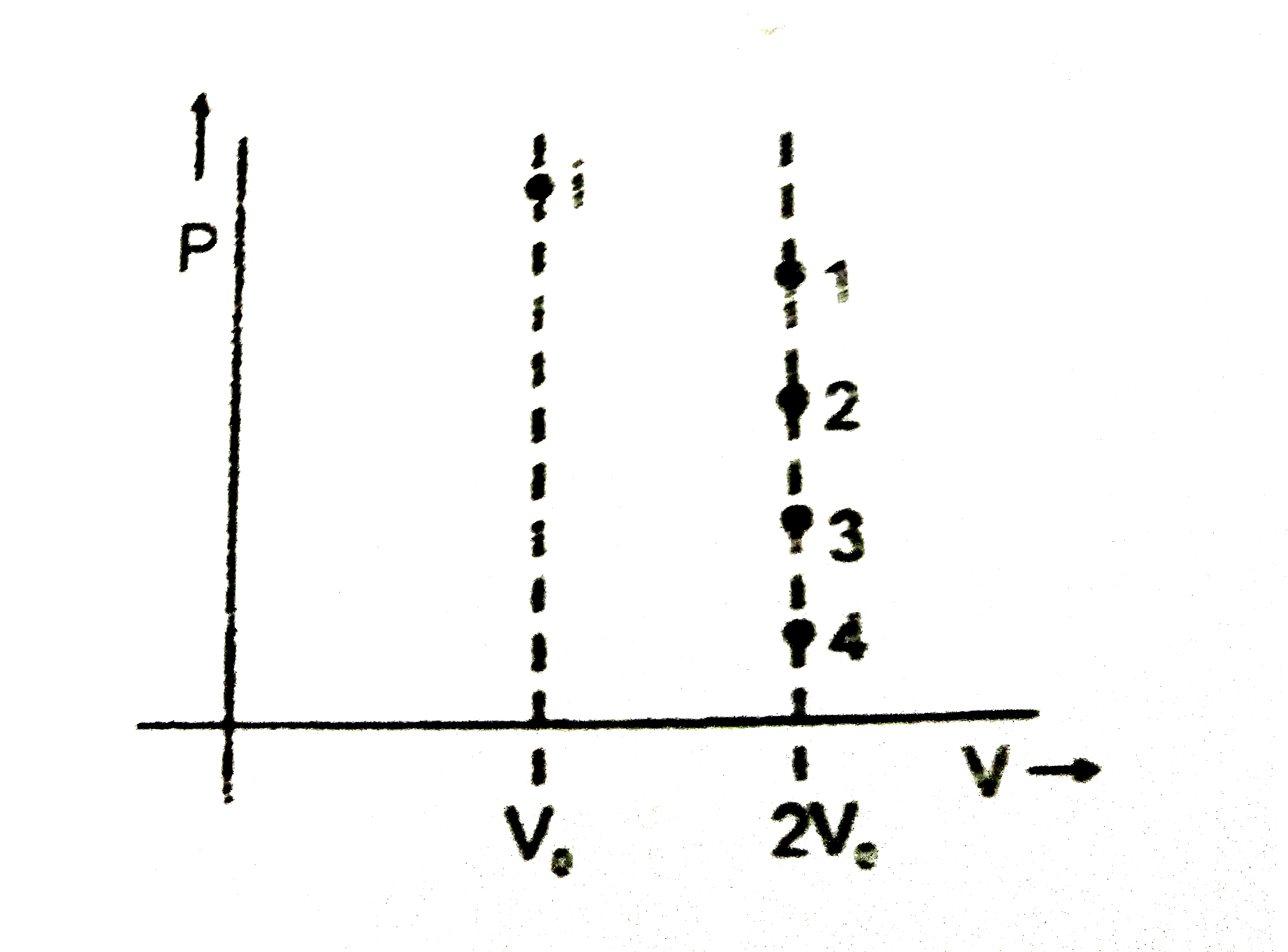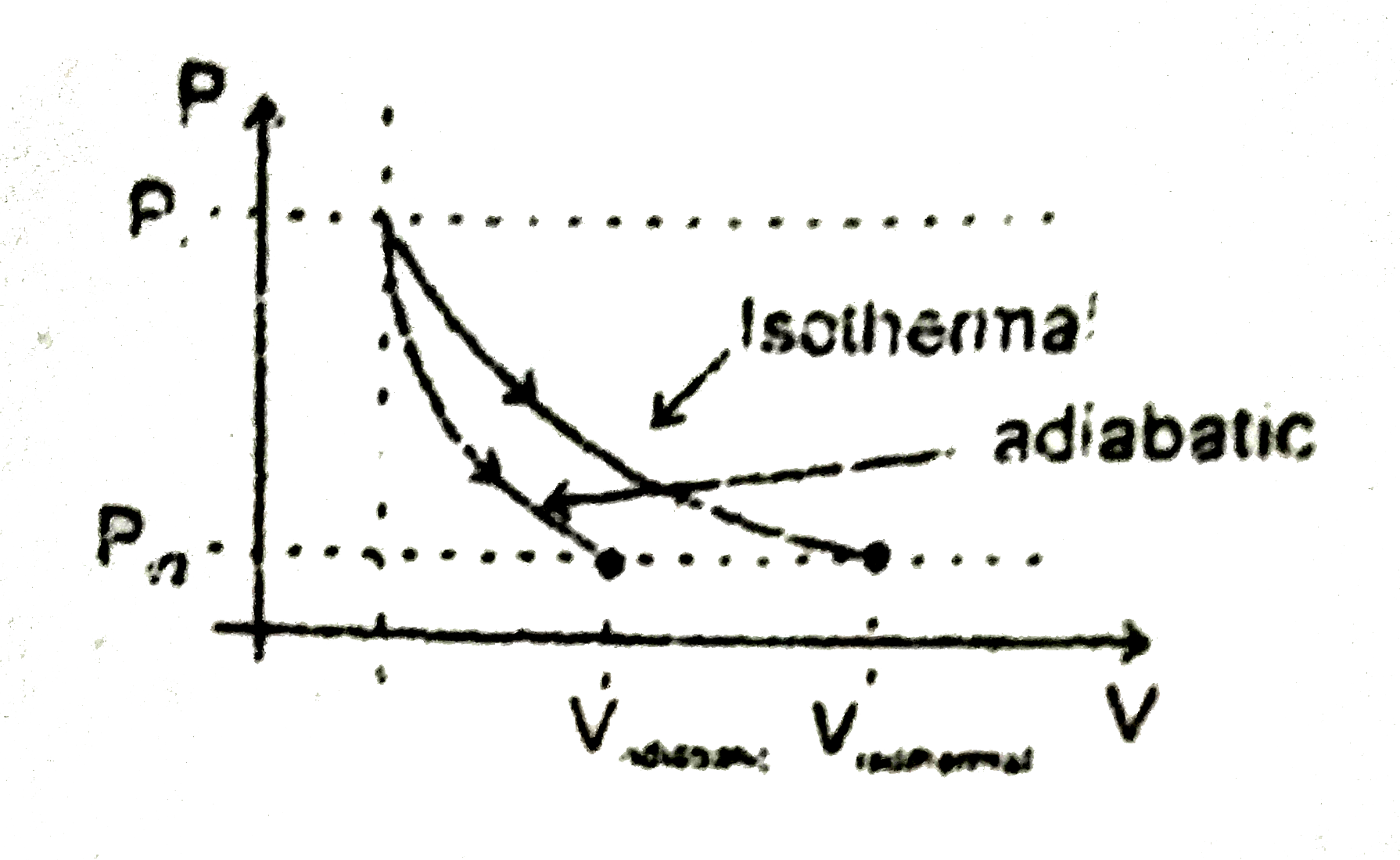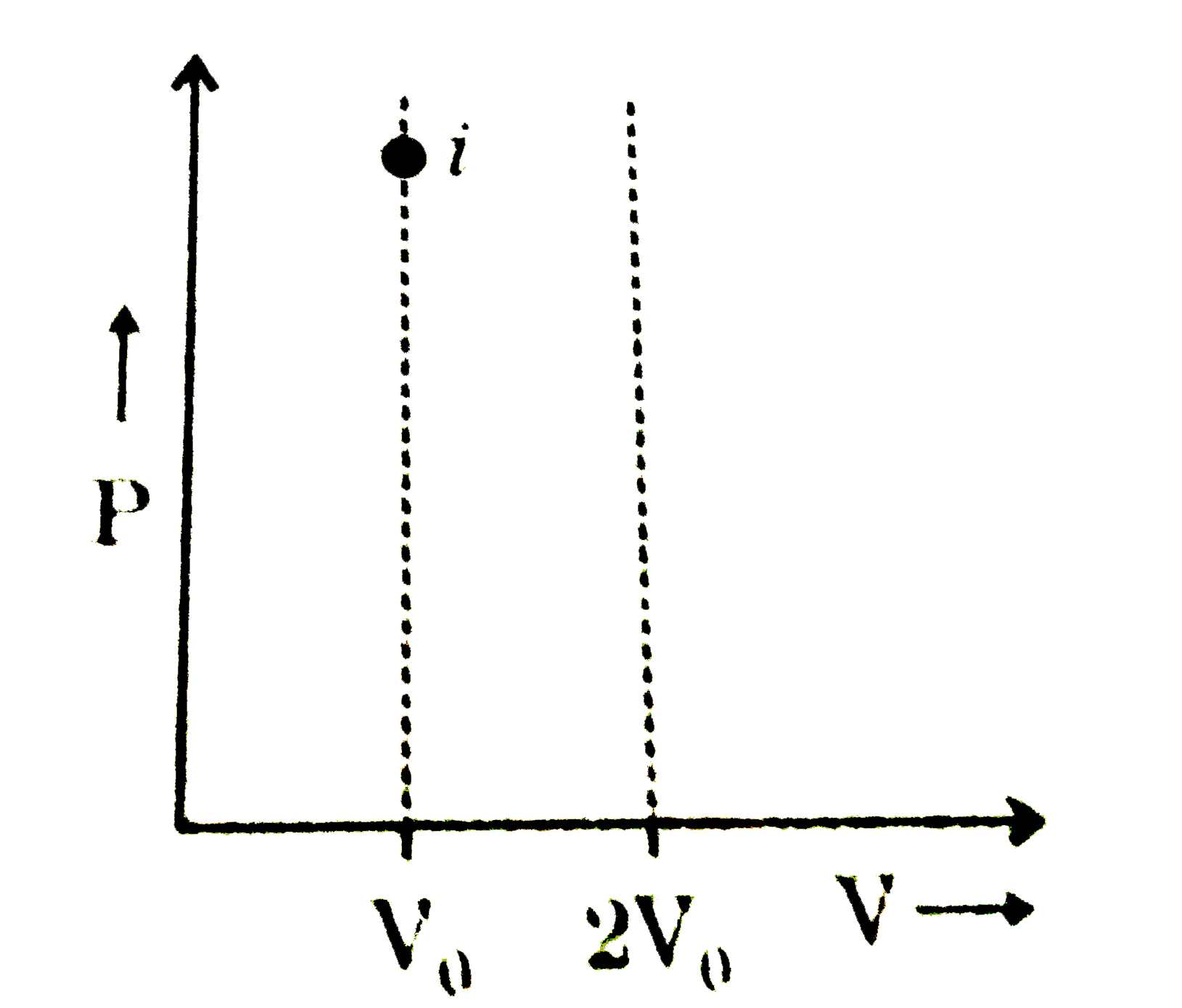A gaseous sample is generally allowed to do only expansion/compression type work against its surroundings The work done in case of an irreversible expansion ( in the intermediate stages of expansion/compression the states of gases are not defined). The work done can be calculated using
dw=−PextdV
while in case of reversible process the work done can be calculated using
dw=−PdV where P is pressure of gas at some intermediate stages. Like for an isothermal reversible process. Since P=nRTV, so
w=∫dW=−vf∫vinRTV.dV=−nRTln(VfVi)
Since dw=PdV so magnitude of work done can also be calculated by calculating the area under the PV curve of the reversible process in PV diagram.
If four identical samples of an ideal gas initially at similar state (P0,V0,T0) are allowed to expand to double their volumes by four different process.
I: by isothermal irreversible process
II: by reversible process having equation P2V= constant
III. by reversible adiabatic process
IV. by irreversible adiabatic expansion against constant external pressure.
Then, in the graph shown in the final state is represented by four different points then, the correct match can be

Final volume of both the samples < final volume of IInd sample
Final volume of IInd sample < final volume of Ind sample
Final volumes will be equal
Information is insufficient
The correct Answer is:B
clearly (Vf)isothermal>(Vf)adiabatic

Topper's Solved these Questions
- THERMODYNAMICSBOOK - RESONANCE ENGLISHCHAPTER - THERMODYNAMICSEXERCISE - Exercise-3 Part-1: JEE (ADVANCED)
11 Videos
- THERMODYNAMICSBOOK - RESONANCE ENGLISHCHAPTER - THERMODYNAMICSEXERCISE - Main
5 Videos
- THERMODYNAMICSBOOK - RESONANCE ENGLISHCHAPTER - THERMODYNAMICSEXERCISE - Exercise 2- III : One or more than one options correct type
14 Videos
- TEST SERIESBOOK - RESONANCE ENGLISHCHAPTER - TEST SERIESEXERCISE - CHEMISTRY
50 Videos
Similar Questions
Cv value of He is always 3R/2 but Cv value of H2 is 3R/2 at low temperature and 5R/2 at moderate temperature and more than 5R/2 at higher temperature. Explain in two or three lines.
View SolutionAn ideal gas expands in volume from 1×10−3m3 to 1×10−2m3 at 300 K against a constant pressure of 1×105Nm−2. The work done is:
View SolutionWhich of the following properties of system are intensive ?
View Solutionwhich of the following plots will obtained for a conductometric titration of strong acid against a weak base?
View SolutionWork Done In Irreversible Process And Free Expansion
View SolutionSelect the correct set of statement/s :
(P) Work done by the surroundings in case of infinite stage expansion is more than single stage expansion.
(Q) Irreversible work is always greater than reversible work.
(R ) In an ideal gas in case of single stage expansion and compression, system as well as surroundings are restored back to their orginal states.
(S) If gas in thermodynamics is equilibrium is taken from state A to state B, by four successive single stage expansion. Then we can plot four points on the P−V indicator diagram.
View SolutionA gaseous sample is generally allowed to do only expansion/compression type of work against its surroundings. The work done in case of an irreversible expansion ( in the intermediate stages of expansion/ compression the states of gases are not defined). The work done can be calculated using
dw=−PextdV
while in case of reversible process the work done can be calculated using
dw=-PdV where P is pressure of gas at some intermediate stages. Like for an isothermal reversible process, since
P=nRTV,so,
w=∫dw=−∫VfVinRTV.dV=−nRT In(VfVi)
Since,dw=PdV, so magnitude of work done can also be calculated by calculating the area under the PV curve of the reversible process in PV diagram.
An ideal gaseous sample at time state i(P0V0T0) is allowed to expand to volume 2V0 using two different processes, in the first process the equation of process is PV2=K1 and in second process the equation of the process is PV=K2. Then :
View SolutionA gaseous sample is generally allowed to do only expansion/compression type of work against its surroundings. The work done in case of an irreversible expansion ( in the intermediate stages of expansion/ compression the states of gases are not defined). The work done can be calculated using dw=-P_("ext")dV while in case of reversible process the work done can be calculated using dw=-PdV where P is pressure of gas at some intermediate stages. Like for an isothermal reversible process, since P=(nRT)/(V) ,so, w=intdw=-int_(V_(i))^(V_(f))(nRT)/(V).dV=-nRT " "In((V_(f))/(V_(i))) Since,dw=PdV, so magnitude of work done can also be calculated by calculating the area under the PV curve of the reversible process in PV diagram. There are two sample of same gas initially at same initial state. Gases of both the sample are expanded. Ist sample using reversible isothermal process and IInd sample using reversible adiabatic process till final pressures of both the samples become half of the initial pressure , then :
View SolutionA gaseous sample is generally allowed to do only expansion/compression type of work against its surroundings. The work done in case of an irreversible expansion ( in the intermediate stages of expansion/ compression the states of gases are not defined). The work done can be calculated using dw=-P_("ext")dV while in case of reversible process the work done can be calculated using dw=-PdV where P is pressure of gas at some intermediate stages. Like for an isothermal reversible process, since P=(nRT)/(V) ,so, w=intdw=-int_(V_(i))^(V_(f))(nRT)/(V).dV=-nRT " "In((V_(f))/(V_(i))) Since,dw=PdV, so magnitude of work done can also be calculated by calculating the area under the PV curve of the reversible process in PV diagram. In the above problem:
View SolutionA gaseous sample is generally allowed to do only expansion/compression type of work against its surroundings. The work done in case of an irreversible expansion ( in the intermediate stages of expansion/ compression the states of gases are not defined). The work done can be calculated using
dw=−PextdV
while in case of reversible process the work done can be calculated using
dw=-PdV where P is pressure of gas at some intermediate stages. Like for an isothermal reversible process, since
P=nRTV,so,
w=∫dw=−∫VfVinRTV.dV=−nRT In(VfVi)
Since,dw=PdV, so magnitude of work done can also be calculated by calculating the area under the PV curve of the reversible process in PV diagram.
If four identical samples of an ideal gas initially at similar state (P0,V0,T0) are allowed to expand to double their volumes by four different processes.

(P)By isothermal irreversible process
(Q) By reversible process having equation P2V= constant
(R) By reversible adiabatic process
(S)By irreversible adiabatic expansion against constant external pressure. Then in the graph shown the final state is represented by four different points then, the correct match can be :
View SolutionA gaseous sample is generally allowed to do only expansion/compression type of work against its surroundings. The work done in case of an irreversible expansion ( in the intermediate stages of expansion/ compression the states of gases are not defined). The work done can be calculated using
dw=−PextdV
while in case of reversible process the work done can be calculated using
dw=-PdV where P is pressure of gas at some intermediate stages. Like for an isothermal reversible process, since
P=nRTV,so,
w=∫dw=−∫VfVinRTV.dV=−nRT In(VfVi)
Since,dw=PdV, so magnitude of work done can also be calculated by calculating the area under the PV curve of the reversible process in PV diagram.
Two samples (initially under same states) of an idea gas are first allowed to expand to doubletheir volume using irreversible isothermal expansion against constant external pressure, then samples are turned back to their original volume first by reversible process having equation PV2= constant then:

View SolutionA gaseous sample is generally allowed to do only expansion // compression type work against its surroundings The work done in case of an irreversible expansion ( in the intermediate stages of expansion // compression the states of gases are not defined). The work done can be calculated using dw= -P_(ext)dV while in case of reversible process the work done can be calculated using dw= -PdV where P is pressure of gas at some intermediate stages. Like for an isothermal reversible process. Since P=(nRT)/(V) , so w=intdW= - underset(v_(i))overset(v_(f))int(nRT)/(V).dV= -nRT ln(V_(f)/(V_(i))) Since dw= PdV so magnitude of work done can also be calculated by calculating the area under the PV curve of the reversible process in PV diagram. In the above problem
View SolutionA gaseous sample is generally allowed to do only expansion // compression type work against its surroundings The work done in case of an irreversible expansion ( in the intermediate stages of expansion // compression the states of gases are not defined). The work done can be calculated using dw= -P_(ext)dV while in case of reversible process the work done can be calculated using dw= -PdV where P is pressure of gas at some intermediate stages. Like for an isothermal reversible process. Since P=(nRT)/(V) , so w=intdW= - underset(v_(i))overset(v_(f))int(nRT)/(V).dV= -nRT ln(V_(f)/(V_(i))) Since dw= PdV so magnitude of work done can also be calculated by calculating the area under the PV curve of the reversible process in PV diagram. If four identical samples of an ideal gas initially at similar state (P_(0),V_(0),T_(0)) are allowed to expand to double their volumes by four different process. I: by isothermal irreversible process II: by reversible process having equation P^(2)V= constant III. by reversible adiabatic process IV. by irreversible adiabatic expansion against constant external pressure. Then, in the graph shown in the final state is represented by four different points then, the correct match can be
View SolutionWork done in a reversible expansion is
View SolutionDuring expansion of a gas into vaccum (Pext=0), Work done is zero if the process is
(A) Reversible (B) Irreversible (C ) Isothermal
View SolutionSelect the correct set of statement/s: I. Work done by the surrounding in case of infinite stage expansion is more than single stage expansion II. Irreversible work is always greater than reversible work. III. On an ideal gas in case of single stage expansion and compression system as well as surrounding are restored back to their original states IV. If gas is in thermodynamic equilibrium is taken from A to state B, by four successive single stage expansions. Then we can plot 4 points on the P-V indicator diagram.
View Solution
